Sphingidae: Philampelini: Eumorpha of Peru
Eumorpha phorbas, Shima, Junin, Peru,
June 12, 2010, courtesy of Peter Bruce-Jones.
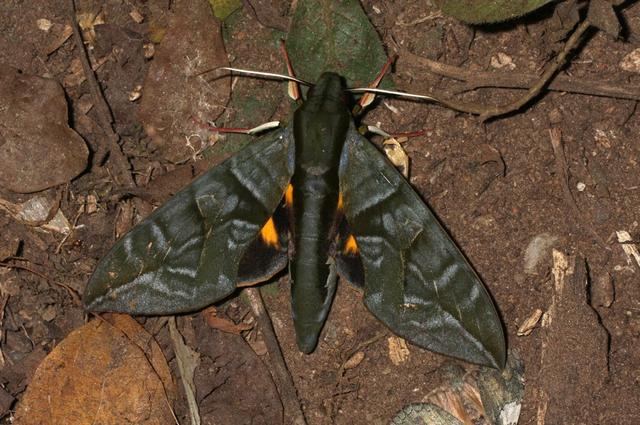
Eumorpha phorbas, Shima, Junin, Peru,
June 12, 2010, courtesy of Peter Bruce-Jones.
This is a very tentative checklist based
primarily on a checklist I had compiled for Ecuador so I fully expect
there are omissions and some erroneous inclusions. If you have
corrections to offer, please contact
This page is inspired by Peter Bruce-Jones who has sent me many images and much data for Sphingidae found in Peru.
Bill Oehlke at
oehlkew@islandtelecom.com.
 |
Eumorpha fasciatus, the Banded Sphinx |
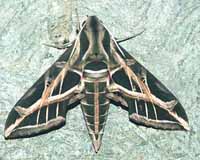 | Eumorpha vitis the Vine Sphinx: Forewing is generally quite similar to fasciatus, but note much longer internal extension of the lowest thin beige post median line into the median area. In fasciatus, this lower thin line in the median area is only a very short dash before meeting the broad transverse lines. Vitis lacks the broad pink band, found in fasciatus, along the hindwing outer margin. |
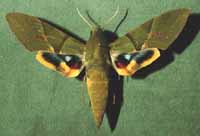 | Eumorpha labruscae the Gaudy Sphinx: Fw ground colour bright green to grey-green with a darker triangular median area, delineated by very dark am line and dark median line. There is a brownish blotch near midpoint of outer line of darker triangular area, followed by a beige blotch along the inner margin. |
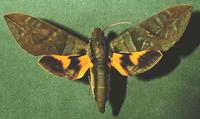 | Eumorpha phorbas: Fw ground colour grey-green with series of lighter grey-green bars, dashes, lines: am line runs straight from costa to inner margin; apical pm line runs straight toward intersection of am line and i.m., but is broken at about 40% of its course by an L-shaped line that turns at about 135 degrees toward aml/im juncture. |
 | Eumorpha megaeacus: Forewing has conspicuous, but ill-defined, pinkish-beige longitudinal band running mostly between CuA1 and CuA2 from wing base, subparallel to inner margin, to near outer margin. Below this band, to inner margin, appears a patchwork of patterns. |
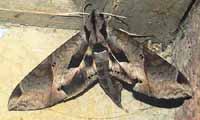 | Eumorpha satellitia: Fw: largely brown, dusted with paler scales, pinkish tone all over. CuA1 conspicuously paler than ground colour. Hw basally buff, i. m. same colour, not pink; dark brown or black submarginal black spots near tornus between CuA1 and 1A. Inner edge of marginal band diffuse. |
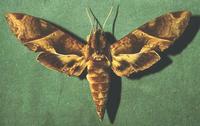 | Eumorpha anchemolus: Fw o. m. slightly crenulated. Similar to Eumorpha triangulum, but fw upperside pattern less contrasting and variegated. Dark subapical costal patch truncated on Rs4. White fringe along i. m. from body to slightly beyond median rhombiform patch very conspicuous. |
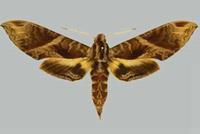 | Eumorpha cissi: Similar to anchemolus, but ground colour: dark greenish-grey; anchemolus: brown. Cissi has more falcate apex. Cissi lacks strongly contrasting white fringe extending (in anchemolus) from body to slightly past dark rhombiform region. Two well defined zigzag lines in pale area along i. m. between dark rhombiform region and anal angle. ? eastesn Colombia |
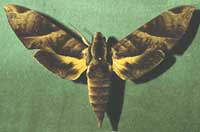 | Eumorpha obliquus: Fw: more glossy grey than anchemolus; three straight oblique parallel lines present in basal area running straight from costal margin to CuP fold; discal spot absent; dark patch near tornus broader than in similar species, rounded triangular; fringe of posterior margin buff, less extensive than anchemolus. |
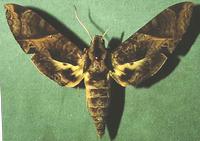 | Eumorpha triangulum: Note the dark trapezoidal patch emanating from the costa just prior to the apex. In E. triangulum this patch continues into the next intraneural segment, giving triangular appearance, while in the very similar E. anchemolus same area remains a trapezoid without "tailed" extension into the next section. Rain forest/cloud forest species unlikely at lower elevations. |
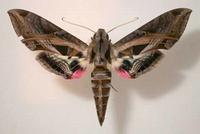 | Eumorpha drucei: Dark, trapezoidal, olive patch midway along i. m. sharply pointed/extended toward o. m.. Boldly marked, orangey veins CuA1, CuA2 have tawny colouration extending toward wing base in pale band. Dark triangular patch near anal angle extends upward to vein CuA1. Broad pink patch on hw anal angle. Discal spot black in offwhite median area. unlikely |
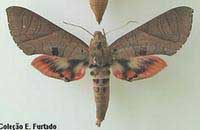 | Eumorpha adamsi: Almost uniformly brown forewing, relatively thin lines, convex forewing outer margin, Similar to Eumorpha translineatus, but distinguishable by bright pink hindwing marginal band and tornal patch. Most pronounced fw line runs obliquely from midpoint of costa toward anal angle. |
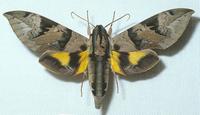 | Eumorpha capronnieri Fw ground colour grey to brown with distinct pattern of mottled green and darker brown areas. Forewing apex is slightly more produced and pointed in capronnieri, compared to phorbas. Note the outward extensions of dark green-brown stripes on abdominal tergites 5 and 6. |
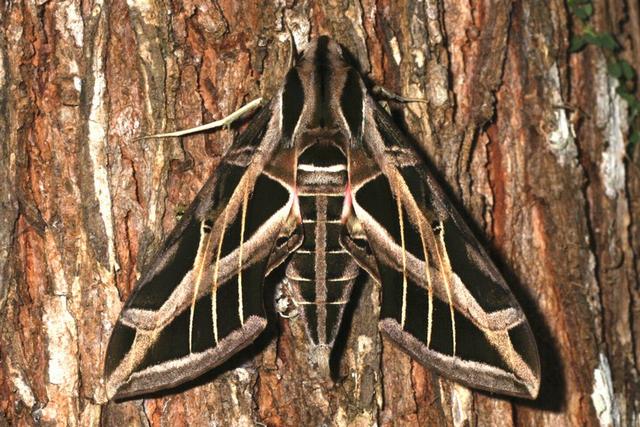
Eumorpha vitis, Shima, Junin, Peru,
June 15, 2010, courtesy of Peter Bruce-Jones.
Go to Indices of Nations
Use your browser "Back" button to return to the previous page.
This page is brought to you by Bill Oehlke and the WLSS. Pages are on space rented from Bizland. If you would like to become a "Patron of the Sphingidae Site", contact Bill.
Please send sightings/images to Bill. I will do my best to respond to requests for identification help.
 Show appreciation for this site by clicking on flashing butterfly to the left. The link will take you to a page with links to many insect sites. |